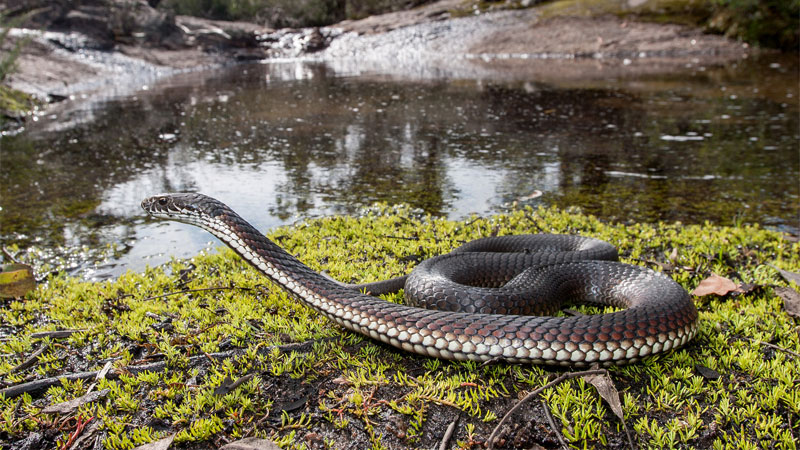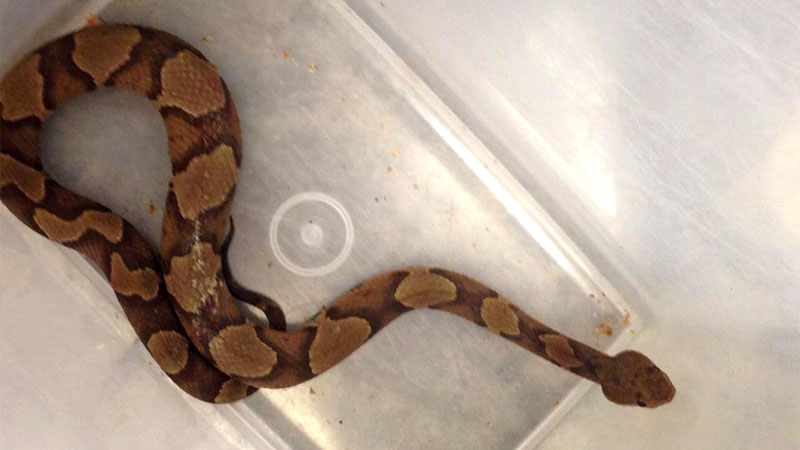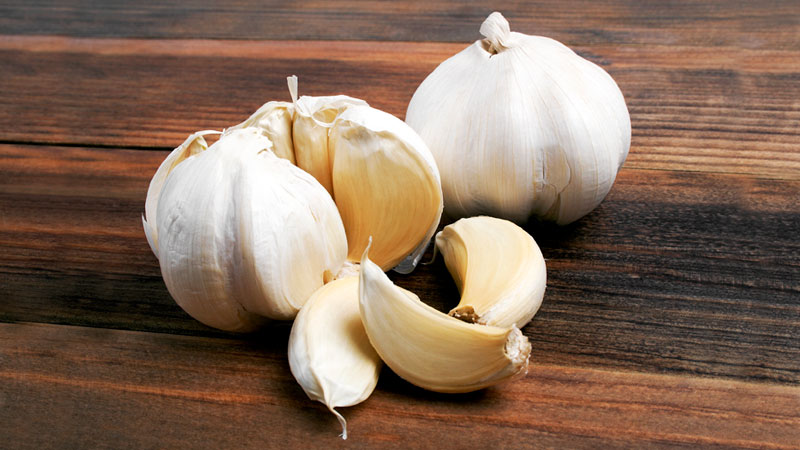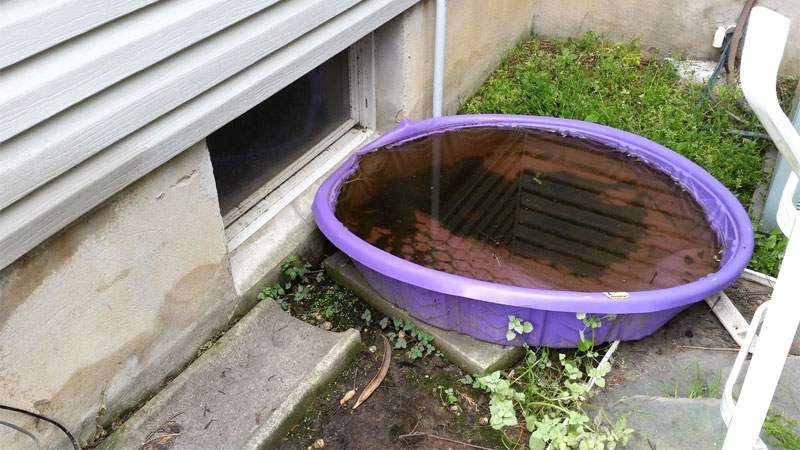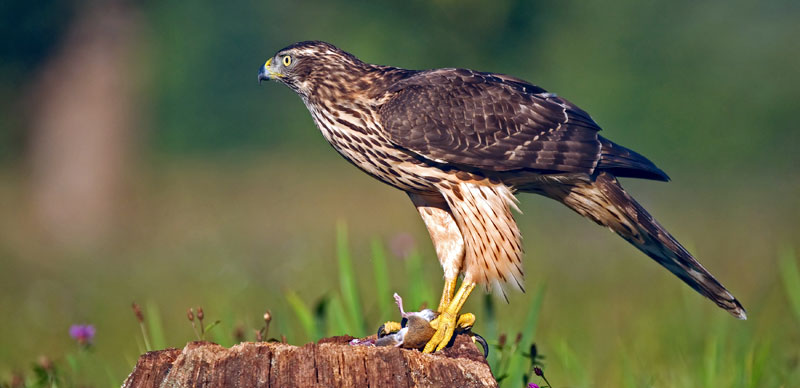There are four different categories of venomous snakes in the US: copperheads, coral snakes, cottonmouths, and rattlesnakes. Out of these, there are seven different species of rattler and one each of the other three native to the US. All of these are considered dangerous and should be avoided.
But today, we’re going to focus on just one, the copperhead (Agkistrodon contortrix). While there are three other snakes also known as copperheads, they’re not related and all live on other continents.
This snake species is quite notorious and the mere name is enough to scare most people. Are they really that dangerous? And what do you do if you find one on your property? Let’s take a closer look from the safety of our monitors and examine some safe methods to get rid of copperheads.
See Also: What To Do If You Find a Snake In Your Basement
Getting to Know Copperhead Snakes
As mentioned, copperheads are one of ten dangerously poisonous snakes in the US, with the majority being species of rattlesnakes. They inhabit the eastern half of the US, moving as far west as Texas to Nebraska and as far north as Iowa to Ohio and parts of New England.
How to Identify a Copperhead Snake
Copperheads generally range in length from 20 to 37 inches and have the angular head typical of venomous species. The head, as their name suggests, is a copper color, and their bellies tend to be shades of tan.
Their backs and sides are usually a reddish brown to yellowish-bronze color with darker spots along the sides that sometimes connect across the back in hourglass shapes.
Young copperheads are a more muted, grayish color, often with yellow at the tip of the tail. However, the exact colors and patterns have a small degree of variation, including different degrees of crossbanding and scales that can be almost pinkish-tan.
The Joy of Variations
For many years, copperheads were considered to consist of three different subspecies, the northern copperhead (Agkistrodon contortrix mokasen), Osage copperhead (Agkistrodon contortrix phaeogaster), and southern copperhead (Agkistrodon contortrix contortrix).
This belief was due largely to the variations in coloration and patterns, but was debunked in 2008 and 2015 when studies revealed there wasn’t enough genetic difference between the three to classify as separate subspecies. As a result, we now only have a single copperhead snake to worry about.
Snakes Commonly Mistaken for Copperheads
Normally, we do some comparisons at the end of the facts section, but there are several other snakes that are commonly mistaken for a copperhead at a distance. Knowing the differences can be extremely important.
Common Watersnake (Nerodia sipedon)
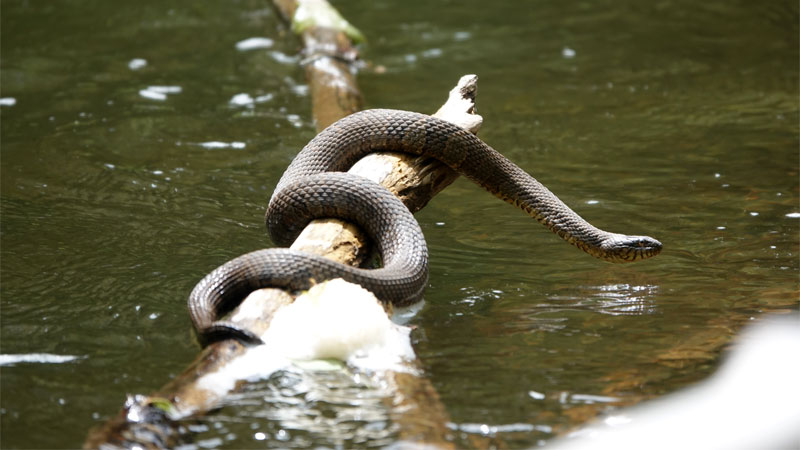
Smaller, darker, and with crossbands that are wider in the middle, the watersnake doesn’t look much like copperheads up close, but still somehow often gets mistaken for one.
Corn Snake (Pantherophis guttatus)
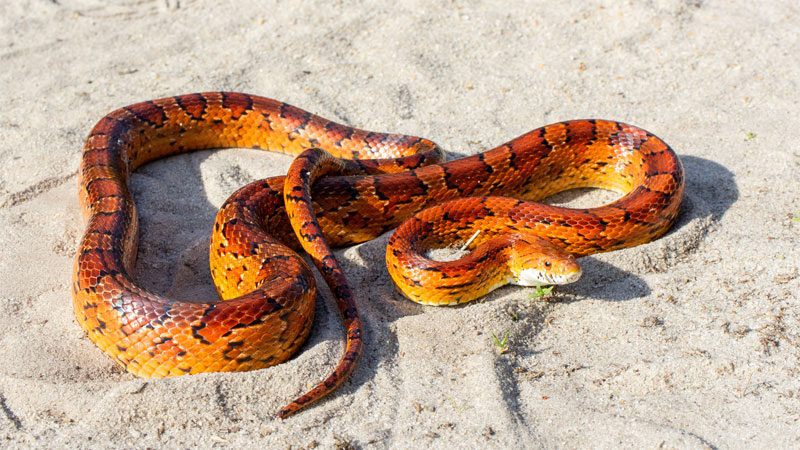
These harmless snakes come in a range of hues that can make them look like copperheads from a distance. However, they’re thinner and their crossbands have a somewhat straighter appearance.
Eastern Hognose Snake (Heterodon platyrhinos)
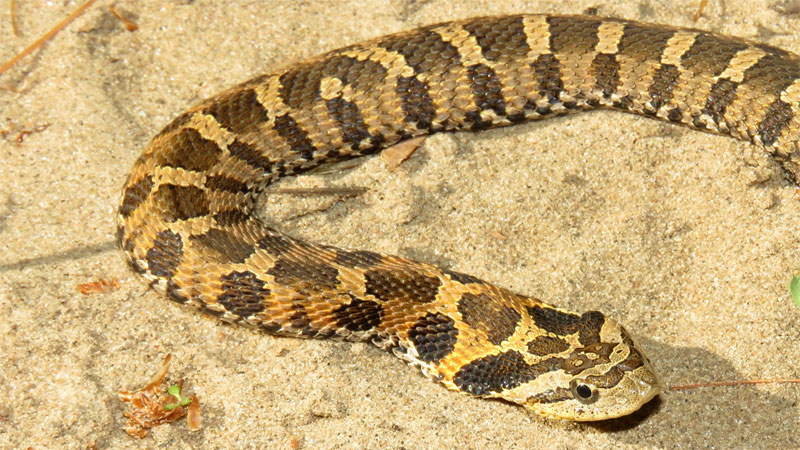
These can look a lot like copperheads but lack any spotting on the sides. They also have an upturned snout and while they lack the head shape of deadlier species, they’ll puff out their neck to scare off predators or even play dead.
Eastern Milk Snake (Lampropeltis triangulum triangulum)
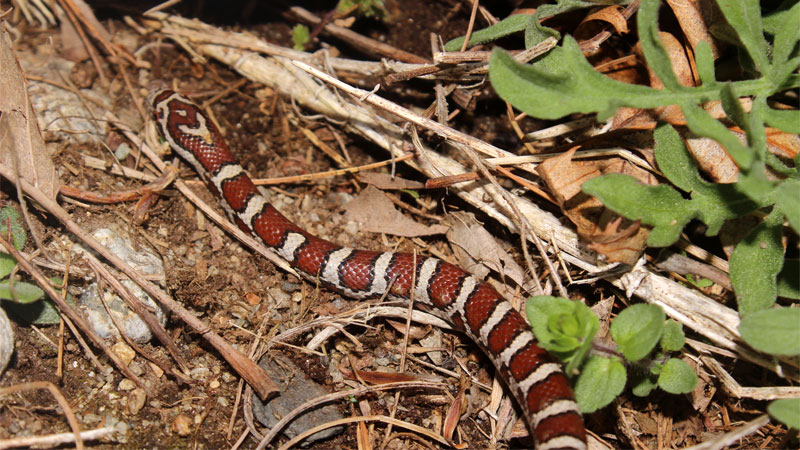
These snakes look a lot like copperheads but with more vibrant coloration. They have light bodies with red spots outlined in black.
Juvenile Black Racer Snake (Coluber constrictor constrictor & Coluber constrictor priapus)
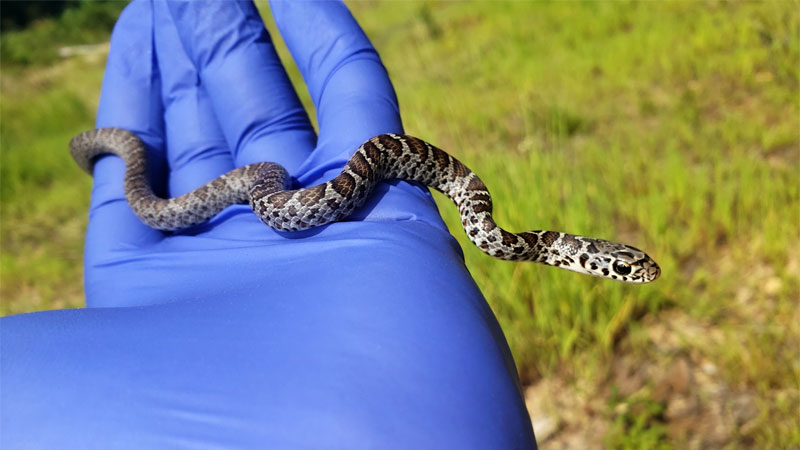
Although they have narrow heads and turn black as they mature, the juveniles of these two subspecies have coloration and markings very similar to copperheads.
Prairie Kingsnake (Lampropeltis calligaster)
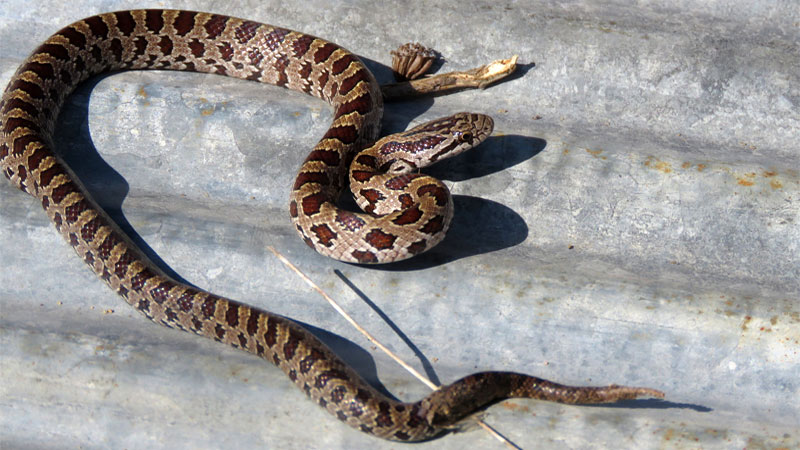
These snakes have a grey to light brown body with splotches of gray, dark brown, or reddish brown that may fade with age.
What To Do if You See a Copperhead
If you see a copperhead (or aren’t sure), the best course of action is to try and avoid it. Don’t let any kids or pets go near where you saw the snake until it can be dealt with.
See Also: 20 Common Pest Phobias
Copperhead Life Cycle
Copperheads mate at the beginning of summer and in early autumn. They give birth instead of laying eggs, and will gestate for between three and nine months, depending on resource availability.
Each brood will have between two and ten young, with the size of the mother directly affecting how many are able to gestate. It takes approximately four years for a copperhead to reach sexual maturity and they can live for up to 18 years in the wild.
What Attracts Copperhead Snakes?
As with most small predators, copperheads are interested in three things: Prey, water, and places to hide from critters that would love to have them for their own lunch.
What Do Copperhead Snakes Eat?
Young copperheads prefer to eat caterpillars and other insects, using their yellow tails as a lure. However, adults are capable of much larger prey and regularly feed on amphibians, lizards, mice, small birds, and even other (smaller) snakes in addition to cicadas and other larger insects.
What Time of Day Are Copperheads Most Active?
Unlike many other species of snake, copperheads don’t like it too hot and will thus be most active in the late afternoon to evening when the ground is giving off warmth but the air is cooling off.
In more southern zones, they’ll often resort to nocturnal activity during the summer months.
Are Copperheads Poisonous?
Copperheads are considered highly venomous (meaning they inject a natural toxin, whereas poisons are ingested substances), but their venom rarely leads to death in adult humans.
This is due to the rather small amount that actually gets injected during a normal bite. The risks are higher for children, smaller pets such as cats and dogs, and those with an autoimmune issue such as the elderly.
In fact, out of all pit vipers, copperheads are considered one of the least lethal (even less than cottonmouths) and are most likely among their kind to give a “dry bite” (meaning no injected venom) when warning away a potential threat.
However, if you suspect you’ve been bitten by a copperhead, you should seek medical attention immediately, as the venom can cause bone and tissue damage (especially in the extremities), sometimes resulting in necrosis or dangerous secondary infections.
Are Copperheads Aggressive?
Thankfully, copperheads are somewhat shy and will avoid a confrontation when possible. However, if you startle or threaten one, it will try to bite in self-defense.
Can Copperheads Climb?
Unlike a lot of other snakes out there, copperheads are fairly poor climbers. In rare cases, they might climb partway up a bush or tree in search of food, but they don’t have the same skills as constrictors and other similar snakes.
Can Copperheads Swim?
As with many snakes, copperheads are excellent swimmers and can often be found in ponds and streams.
Do Copperhead Snakes Smell Like Cucumbers?
This is an entirely subjective claim, so the answer will vary from one person to another. What you do need to know is that all snakes give off a defensive musk when threatened. Some, such as garden snakes, give off a foul odor.
However, the particular odor given off by a copperhead is far less unpleasant. Depending on how your olfactory senses register this odor, it can, indeed, smell a lot like cucumbers.
Just don’t rely on this smell as a confirmation of copperheads, since for every person who smells cucumbers there’s at least one who doesn’t.
How to Get Rid of Copperhead Snakes
Copperheads may not be as deadly as their reputation suggests, but that doesn’t mean you should go around trying to snatch them up or step on one. Here are some different ways to get rid of any copperheads that have decided to invade your property.
Should You Try Killing a Copperhead Snake?
Copperheads aren’t a protected species, so kill methods are perfectly acceptable. However, you have to keep personal safety in mind, meaning any kill methods must be hands-off.
In addition, a dead copperhead can still deliver venom if you aren’t careful, so only handle a (confirmed) dead copperhead with heavy gloves and hold it behind the head with one hand and further down the body with the other so there’s minimal risk of coming in contact with the snake’s fangs.
Be warned, some states and regions have laws restricting the use of kill methods against snakes, not out of concern for the snake or environment, but rather due to the risks to humans if the method fails.
Always take a moment to check up on ordinances before using kill methods on any critter just to be safe (no pun intended).
Do Home Remedies Actually Work?
We’re normally all for home remedies, but sometimes they’re little more than wives’ tales or have only circumstantial evidence to support their value. The following are some home remedies, whether or not they work, and how to use them if they do.
Ammonia
Let’s get one thing straight: you should NEVER spray ammonia on or near plants, as the substance has a staggering alkaline pH of 11. Considering a pH over 7.3 (neutral) will kill most plants, you can easily see why this is a bad idea.
That said, using predator urine crystals can be highly effective at deterring snakes and other pests. Just keep in mind it needs to be a snake-eating predator’s urine you’re sprinkling, and the crystals have a habit of dissolving in rain. You’ll have to reapply them every after storms as well as periodically (check the label for exact frequency).
White Vinegar
This is pretty much the same deal as with ammonia, only at the opposite end of the pH scale. Most plants will die at a pH under 5.5 (although some vegetables can handle a slightly lower pH), and white vinegar has an extremely acidic 3.0 pH.
However, a diluted spray used near plants will usually not harm them as long as you don’t get the vinegar ON the plants.
Essential Oils
Essential oils (and extracts) are known to work as an effective repellent against copperheads. Keep in mind, their effectiveness dissipates over time and will wash away in rain.
You can mix and match these oils or use them individually. Some good choices include: cinnamon, cloves, lemon or lime juice, and peppermint.
Garlic
Ahh, yes, the superfood that is garlic invariably comes up with almost any critter. We’ll talk about the plant later, but what about the smell itself?
Well, we actually know from herpetologists (people who study amphibians and reptiles) that garlic can repel snakes, and people who own pet snakes can observe this behavior for themselves. Thus, we can safely say that garlic sprays are a viable repellent option.
Human-Smelling Items
This is a rather strange home remedy that you see pop up on rare occasions. The idea is to leave some dirty laundry (such as socks) or some hair from a brush around.
Country bumpkins often claim the smell of humans will scare snakes away, but there’s no substantive evidence to support these claims. More importantly, if the scent of people scared copperheads away, we wouldn’t have so many entering suburban and even urban settings.
Mothballs
Mothballs have a very controversial history. Not only were they originally highly toxic (and aren’t a whole lot better now), but their effectiveness can vary greatly from one critter to another.
We’re sorry (or not, since these are an overrated remedy) to say that mothballs are completely useless against copperheads.
Sprays and Traps
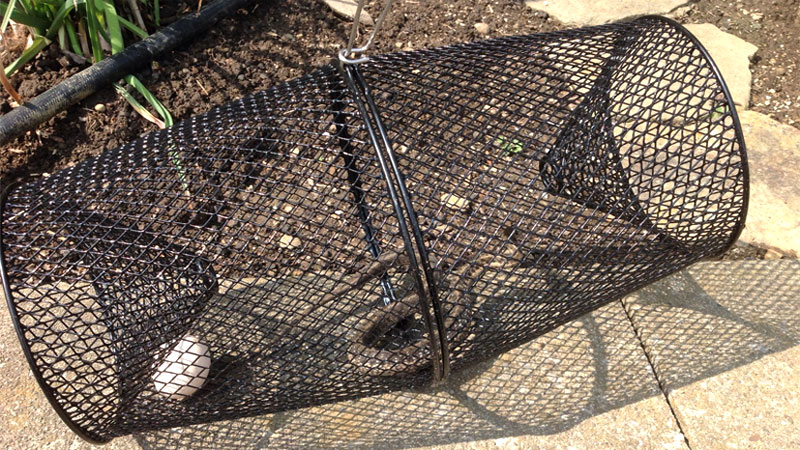
There are a lot of good commercial products out here that work pretty well against copperheads. Here are just a few that have a proven track record.
Minnow Traps
These are Uncle Fester’s arch nemeses, only upscaled. The trap is inverted on both sides with funnel entrances. You put the bait inside (a rotten egg tends to be rather effective). The snake enters the trap hoping for an easy meal only to get itself stuck.
Snake Sprays
You’ll have to practice some caution when investing in a snake pesticidal spray, as some work and others are worthless.
Snake Away is one of the more popular products out there but it’s not very effective when it comes to copperheads. The product contains the same chemicals that used to be the primary ingredient in mothballs (Naphthalene), and while this can have some effect on certain snakes, copperheads seem to be mostly unaffected by it.
Professional Grade Products
For the best chance of success at getting rid of copperheads, use what the professionals use. Commercial-grade products aren’t often available at your local Tractor Supply or even Amazon. Companies such as DoMyOwn.com have an entire line of snake control products that have been proven to get results.
How to Keep Copperhead Snakes Away From Your Yard
There are three main tactics to keep copperheads from wanting to enter your property. This involves making the area as hostile to the snakes as possible by removing resources and shelter, inviting predators, and using plants that repel snakes.
Get Rid of Resources and Shelter
Snakes want food, water, and places to hide, so it’s a good idea to ensure they have none of these. Here are just a few ways to show them there’s no room at the inn.
Keeping the Yard Clean
Keep your grass short and keep the property free of leaf litter and other debris. You will also want to avoid using large rocks as decoration unless you’re planting repellent plants nearby.
Woodpiles and rotting wood are also popular hiding spots, so be sure to keep any wood piles elevated to make them less attractive. Planting some mint around the base of your wood storage will help keep them away.
Structures
Make sure any structures such as sheds are kept uncluttered and any structures or crawlspaces have been sealed to prevent entry. You can also erect snake fencing, which is essentially a mesh fence with openings no larger than ¼ inches wide. You’ll also want to get rid of any standing water on the property.
Remove the Food
Finally, be sure to get rid of any critters that would be an attractive meal for copperheads. They’re far less likely to want to visit a buffet when the kitchen’s closed. This means eliminating any known insect pests.
Remember, snakes have an amazing sense of smell (and often poor eyesight), so that hidden colony of carpenter ants could result in a snake infestation.
Remove Standing Water
On a related note, don’t leave standing water on your property. If you have a water feature, be sure to add a pump to keep things moving. This will discourage mosquitoes, no-see-ums, and other little nasties from breeding.
While these pests may not be directly on a copperhead’s menu, they can attract other predators that snakes find tasty.
Employ Natural Predators
Copperheads have a lot of natural enemies, including a wide range of other snakes. In fact, snakes are very good at hunting each other down. Some copperhead-snacking slitherers include:
- Coral snakes
- Cottonmouths
- Garter snakes
- Kingsnakes
- Racer snakes
Additionally, a lot of other critters will go after copperheads. Your cat or dog will consider them a tasty snack, although letting them do so can be quite risky.
Many birds, such as chickens, hawks, and owls, all actively hunt snakes. Other known predators are larger frogs (such as bullfrogs), coyotes and other wild canines, and opossums.
Obviously, you don’t want some of these critters visiting your backyard, but those you’re comfortable having around can be valuable allies.
Complimentary Gardening
One of the best-kept secrets of successful gardening is the fine art of complimentary gardening (AKA companion planting). This technique makes use of the natural capabilities of certain plants to attract or repel critters, as well as the ability of some to boost the growth of nearby plants.
There are some really great plants you can mix into your flower or crop gardens, or simply plant around the perimeter of your property. Not only are these plants attractive and often edible, they’re really good at keeping both copperheads and their prey at bay.
Some great choices include:
- Alliums (chives, garlic, onions, etc.)
- Citrus
- Green chiretta
- Lemongrass
- Marigold
- Mint (especially peppermint)
- Mugwort
- Snakeplant (Sansevieria trifasciata – the leaves resemble snakes in shape, which can often intimidate copperheads)
- Yucca
- How to Get Rid of Hawks - March 8, 2024
- How to Get Rid of Pill Bugs (Rolly Pollies) - March 1, 2024
- How to Get Rid of Groundhogs (Woodchucks) - February 5, 2024

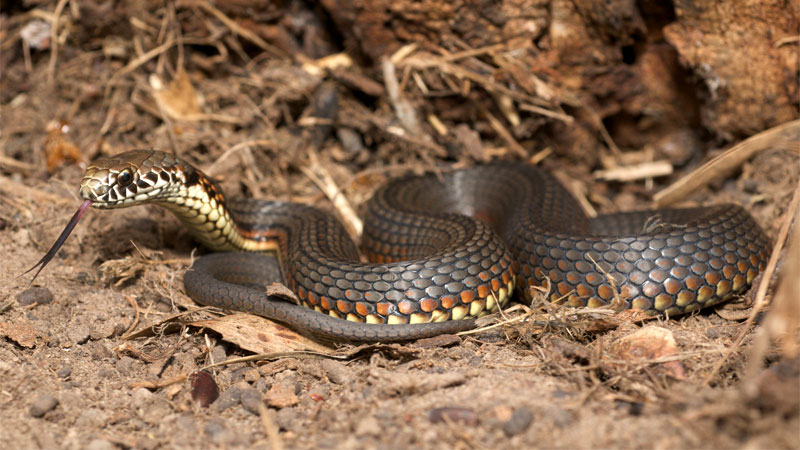
 Just tell me how to get rid of ’em.
Just tell me how to get rid of ’em.
